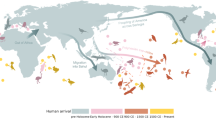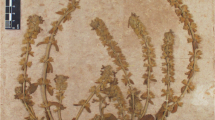Abstract
Rediscoveries of species previously thought to be extinct present a dilemma to conservation biology. On one hand, such instances offer the chance to change the course of events away from one that would have led to extinctions. On the other hand, public support for conservation may wane if scientists are frequently seen to overstate and prematurely declare extinctions. Recent studies have adopted a probabilistic approach to infer extinction, using sightings or collections and statistical models to calculate the chance that a species may still be extant. We conduct the first broad-scale test of such models using a recently compiled national red list and national herbarium collection records, including collections of presumed nationally extinct species made after the red list publication, which constitute “rediscoveries”. There was little evidence that the probabilities calculated by these models were associated with rediscoveries over a 3.5-year period. Current probabilistic models of extinction using sighting records could hence be inadequate for use with most natural history collection data.

Similar content being viewed by others
References
Ang WF, Lok AFSL, Tan HTW (2010a) Rediscovery in Singapore of Pinanga simplicifrons (Miq.) Becc. (Arecaceae). Nat Singap 3: 83–86. Available online: http://rmbr.nus.edu.sg/nis/bulletin2010/2010nis083-086.pdf
Ang WF, Lok AFSL, Yeo CK, Tan SY, Tan HTW (2010b) Rediscovery of Dendrobium aloifolium (Blume) Rchb.f. (Orchidaceae) in Singapore. Nat Singap 3: 321–325. Available online: http://rmbr.nus.edu.sg/nis/bulletin2010/2010nis321-325.pdf
Brook BW, Sodhi NS, Ng PKL (2003) Catastrophic extinctions follow deforestation in Singapore. Nature 424:420–423
Burnham KP, Anderson DR (2002) Model selection and multi-model inference: a practical information-theoretic approach. Springer, New York
Butchart SHM, Stattersfield AJ, Brooks TM (2006) Going or gone: defining ‘possibly extinct’ species to give a truer picture of recent extinctions. Bull Br Ornithol Club 126A:7–24
Carpaneto GM, Mazziotta A, Valerio L (2007) Inferring species decline from collection records: roller dung beetles in Italy (Coleoptera, Scarabaeidae). Divers Distrib 13:903–919
Collar NJ (1998) Extinction by assumption; or, the Romeo error on Cebu. Oryx 32:239–244
Collen B, Purvis A, Mace GM (2010) When is a species really extinct? Testing extinction inference from a sighting record to inform conservation assessment. Divers Distrib 16:755–764
Corlett RT (2009) Seed dispersal distances and plant migration potential in Tropical East Asia. Biotropica 41:592–598
de Iongh HH, Bal D (2007) Harmonization of Red Lists in Europe: some lessons learned in the Netherlands when applying the new IUCN Red List Categories and Critieria version 3.1. Endanger Species Res 3:53–60
Duffy KJ, Kingston NE, Sayers BA, Roberts DL, Stout JC (2009) Inferring national and regional declines of rare orchid species with probabilistic models. Conserv Biol 23:184–195
Dutson GCL, Magsalay PM, Timmins RJ (1993) The rediscovery of the Cebu Flowerpecker Diaceum quadricolor, with notes on other forest birds on Cebu, Philippines. Bird Conserv Int 3:235–243
Fisher DO, Blomberg SP (2011) Correlates of rediscovery and the detectability of extinction in mammals. Proc R Soc B 278:1090–1097
Fitzpatrick JW, Lammertink M, Luneau DM Jr, Gallagher TW, Harrison BR, Sparling GM, Rosenberg KV, Rohrbaugh RW, Swarthout ECH, Wrege PH, Swarthout SB, Dantzker MS, Charif RA, Barksdale TR, Remsen JV Jr, Simon SD, Douglas Z (2005) Ivory-billed Woodpecker (Campephilus principalis) persists in continental North America. Science 308:1460–1462
Fitzpatrick JW, Lammertink M, Luneau DM Jr, Gallagher TW, Rosenberg KV (2006a) Response to comment on “Ivory-billed Woodpecker (Campephilus principalis) persists in continental North America”. Science 311:1555b
Fitzpatrick JW, Lammertink M, Luneau DM Jr, Rosenberg KV, Gallagher TW, Rohrbaugh RW (2006b) Response to “Ivory-billed or Pileated Woodpecker?”. Science 315:1496
Fitzpatrick JW, Lammertink M, Luneau DM Jr, Gallagher TW, Harrison BR, Sparling GM, Rosenberg KV, Rohrbaugh RW, Swarthout ECH, Wrege PH, Swarthout SB, Dantzker MS, Charif RA, Barksdale TR, Remsen JV Jr, Simon SD, Douglas Z (2006c) Clarifications about current research on the status of Ivory-billed Woodpecker (Campephilus principalis) in Arkansas. Auk 123:587–593
Hance J (2011) Worldwide search for ‘lost frogs’ ends with 4 % success, but some surprises. http://news.mongabay.com/2011/0215-hance_lostfrogs.html Accessed 31 Aug 2011
Jackson JA (2006) Ivoy-billed Woodpecker (Campephilus principalis): hope, and the interfaces of science, conservation, and politics. Auk 123:1–15
Keith DA, Burgman MA (2004) The Lazarus effect: can the dynamics of extinct species lists tell us anything about the status of biodiversity? Biol Conserv 117:41–48
Keller V, Zbinden N, Schmid H, Volet B (2005) A case study in applying the IUCN regional guidelines for national Red Lists and justifications for their modification. Conserv Biol 19:1827–1834
Ladle RJ, Jepson P, Araújo MB, Whittaker RJ (2004) Dangers of crying wolf over risk of extinctions. Nature 428:799
Lee SML, Samsuri A, Leong P, Gwee AT, Kiew R (2005) Extinct species. Gardenwise 24:12
Leong P (2005) Rediscovery of extinct native orchids. Gardenwise 24:12–13
Lok ASFL, Ang WF, Chong KY, Tan HTW (2010) Rediscovery of Liparis barbata Lindl. (Orchidaceae) in Singapore. Nature Singapore 3: 277–281. Available online: http://rmbr.nus.edu.sg/nis/bulletin2010/2010nis277-281.pdf
McCarthy MA (1998) Indentifying declining and threatened species with museum data. Biol Conserv 83:9–17
McInerny GJ, Roberts DL, Davy AJ, Cribb PJ (2006) Significance of sighting rate in inferring extinction and threat. Conserv Biol 20:562–567
Mikusinski G, Blicharska M, Baxter PWJ (2010) Costs and benefits of ivory-billed woodpecker “rediscovery”. Front Ecol Environ 8:460
Pimm SL, Jenkins CN (2010) Extinctions and the practice of preventing them. In: Sodhi NS, Ehrlich PR (eds) Conservation biology for all. Oxford University Press, UK, pp 181–199
Rabor DS (1959) The impact of deforestation on birds of Cebu, Philippines, with new records for that island. Auk 76:37–43
Rivadeneira MM, Hunt G, Roy K (2009) The use of sighting records to infer species extinctions: an evaluation of different methods. Ecology 90:1291–1300
Roberts DL (2006) Extinct of possibly extinct? Science 312:997
Roberts DL, Solow AR (2003) When did the dodo become extinct? Nature 426:245
Roberts DL, Elphick CS, Reed JM (2010) Identifying anomalous reports of putatively extinct species and why it matters. Conserv Biol 24:189–196
R Development Core Team (2009) R: a language and environment for statistical computing. R Foundation for Statistical Computing, Vienna. http://www.R-project.org
Sibley DA, Bevier LR, Patten MA, Elphick CS (2006a) Comment on “Ivory-billed Woodpecker (Campephilus principalis) persists in continental North America”. Science 311:1555a
Sibley DA, Bevier LR, Patten MA, Elphick CS (2006b) Ivory-billed or Pileated Woodpecker? Science 315:1495
Sodhi NS, Koh LP, Peh KS-H, Tan HTW, Chazdon RL, Corlett RT, Lee TM, Colwell RK, Brook BW, Sekercioglu CH, Bradshaw CJA (2008) Correlates of extinction proneness in tropical angiosperms. Divers Distrib 14:1–10
Sodhi NS, Brook BW, Bradshaw CJA (2009) Causes and consequences of species extinctions. In: Levin SA (ed) The Princeton guide to ecology. Princeton University Press, USA, pp 515–520
Solow AR (1993a) Inferring extinction from sighting data. Ecology 74:962–964
Solow AR (1993b) Inferring extinction in a declining population. J Math Biol 32:79–82
Solow AR (2005) Inferring extinction from a sighting record. Math Biosci 195:47–55
Solow AR, Roberts DL (2003) A nonparametric test for extinction based on a sighting record. Ecology 84:1329
Tan BC, Tan HTW, Tan K-x, Ibrahim AB, Chew PT, Chua KS, Gwee AT, Kiew R, Lee SML, Leong P, Lok AFSL, Loo AHB, Lum SKY, Morgany T, Suran SB, Sim S, Ahmad HSBH, Wee YC, Yeo CK, Yong JWH (2008) Checklists of threatened species—Ferns and fern allies. In: Davison GWH, Ng PKL, Ho HC (eds) The Singapore Red Data Book, 2nd edn. The Nature Society (Singapore), Singapore, pp 210–212
Tan HTW, Tan K-x, Ibrahim AB, Chew PT, Chua KS, Duistermaat H, Ganesan SK, Goh MWK, Gwee AT, Kiew R, Lee SML, Leong P, Lim J, Lok AFSL, Loo AHB, Lum SKY, Morgany T, Suran SB, Sim S, Ahmad HSBH, Wee YC, Yap KF, Yeo CK, Yong JWH (2008) Checklists of Threatened species—Seed plants In: Davison GWH, Ng PKL, Ho HC (eds) The Singapore Red Data Book, 2nd edn. The Nature Society (Singapore), Singapore, pp 213–244
Acknowledgments
K.Y.C. is grateful to the Department of Biological Sciences, National University of Singapore, for sponsoring the conference expenses. We thank Wong Khoon Meng and the reviewers for their thoughtful comments and suggestions. We would also like to thank the Singapore Botanic Gardens Herbarium and the National Parks Board (Singapore) for access to the collections database, and Jeremy Woon for facilitating the Research Permits (RP977 and RP943).
Author information
Authors and Affiliations
Corresponding author
Electronic supplementary material
Below is the link to the electronic supplementary material.
Rights and permissions
About this article
Cite this article
Chong, K.Y., Lee, S.M.L., Gwee, A.T. et al. Herbarium records do not predict rediscovery of presumed nationally extinct species. Biodivers Conserv 21, 2589–2599 (2012). https://doi.org/10.1007/s10531-012-0319-x
Received:
Accepted:
Published:
Issue Date:
DOI: https://doi.org/10.1007/s10531-012-0319-x




